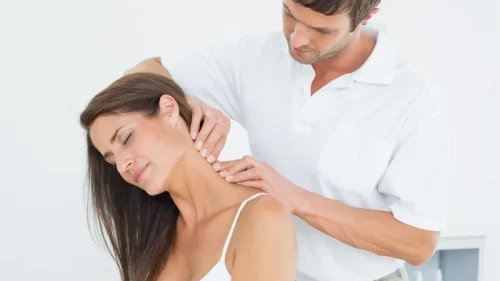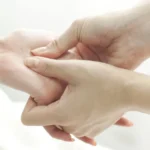Looking to give a calming back and neck massage? With just a few simple techniques, you can help someone release tension, unwind, and feel completely cared for. This guide shows you how to apply the right pressure, use smooth, flowing movements, and create an atmosphere that encourages deep relaxation. 🌿✨
Whether you’re brand new to massage or refining your skills, you’ll learn how to support your partner, friend, or family member with a soothing experience that feels grounding, comfortable, and genuinely enjoyable.
Table of Contents
Benefits of Back and Neck Massage

Back and neck massages offer powerful physical and emotional benefits. On a physical level, they help release muscle tension, ease stiffness, support joint mobility, and improve circulation so the tissues receive more oxygen and nutrients. Many people also notice reduced headaches and overall better posture. Emotionally, a calming massage can lower stress, improve sleep, and create a deeper sense of relaxation and well-being. The blend of touch, warmth, and slow rhythmic movement makes this style of massage especially comforting. 🌿✨
Preparing to Give a Back and Neck Massage
Gather Your Supplies
Before you begin, set yourself up for a smooth, relaxing experience. You’ll need a comfortable surface such as a massage table, firm bed, or cushioned floor mat, along with a light massage oil or lotion and a couple of clean towels. Choose a space that feels calm, private, and free from interruptions so the person receiving the massage can fully unwind. 🌿
Set the Atmosphere
A soothing environment makes a huge difference. Consider dimming the lights, putting on soft music, or using a diffuser with calming essential oils like lavender or eucalyptus. Warmth, gentle scents, and quiet surroundings help the body relax faster, making the back and neck massage much more effective. ✨
Giving a Back and Neck Massage

Start With the Neck
Begin by gently resting your hands on the neck and upper shoulders. Use slow, circular motions to warm the muscles and help the person relax. Keep the pressure light to moderate—just enough to soften tension without causing discomfort. Focus on the sides of the neck and the tops of the shoulders, where stress often builds up. 🌿
Move to the Shoulders
Once the neck feels looser, slide your hands down to the shoulders. Use your thumbs to trace small circles along the tops and sides of the shoulder blades, avoiding direct pressure on the bones. Work slowly, pausing on any tight spots to let the muscles release. This area responds well to steady, rhythmic kneading. ✨
Massage the Upper Back
Glide your hands down the upper back, working on the muscles alongside the spine—never directly on the spine itself. Use your palms or fingertips to make long strokes away from the center of the back, and knead the trapezius and rhomboids gently. These broad muscles benefit from slow, consistent pressure rather than anything sharp or deep.
Massage the Mid–Lower Back
For the mid and lower back, continue using your palms or the soft pads of your fingers. Work in long, sweeping motions and avoid elbows or knuckles, which can feel too intense or unsafe. Keep the pressure comfortably firm but controlled, following the natural lines of the back muscles. Encourage relaxation by moving slowly and checking in if needed. 🧘♀️
Finish With the Arms
End the massage by softly working down each arm. Start at the shoulder, then move toward the elbow and wrist with gentle, gliding strokes. Use your thumbs to make small circles over the forearm muscles and finish with a relaxing sweep across the palms and fingers. This helps complete the full-body sense of release and grounding. 💛
Aftercare Tips
After a back and neck massage, a few simple aftercare steps can help the body settle and enhance the benefits of the session. 🌿
Stay Comfortable and Rest
Encourage the person to stay in a relaxed position for a few minutes after the massage. Whether lying on their back, stomach, or side, this brief rest helps the nervous system shift into a calmer state and allows the muscles to fully release.
Drink Water
Sipping water after a massage supports overall hydration and helps the tissues recover more comfortably. It’s especially helpful if deeper pressure was used or if the person tends to feel sore after massage. 💧
Avoid Strenuous Activity
Heavy lifting, intense workouts, or repetitive strain should be avoided for a few hours. The muscles are more relaxed and pliable after a massage, and giving them time to settle helps prevent tension from returning too quickly.
Use Gentle Heat
Applying a warm compress or taking a warm shower can soothe the muscles and ease any mild soreness that appears later. Heat encourages blood flow and can extend the relaxing effects of the massage. ✨

Possible Contraindications
Before giving a back and neck massage, it’s important to check for any conditions that may require caution or mean the massage should be avoided. These considerations help keep both you and the person receiving the massage safe. 🌿
When to Avoid or Delay a Massage
Massage should not be performed over areas with:
- Infectious skin conditions (such as rashes, fungal infections, or contagious skin issues)
- Open wounds or cuts
- Recent injuries, including sprains, strains, or severe inflammation
- Fractures or suspected fractures
- Visible swelling or bruising
Medical Conditions Requiring Professional Clearance
Massage may not be appropriate—or may need modification—if someone has:
- Blood clots or a history of deep vein thrombosis (DVT) ⚠️
- Circulatory issues, including severe varicose veins
- Uncontrolled heart conditions
- Fever or active infection
- Recent surgery, especially if the area is still healing
- Cancer or tumors, unless cleared by a medical professional
If there is ever uncertainty, it’s safest to seek advice from a healthcare provider before continuing.
Frequently Asked Questions
What type of massage oil is best for a back and neck massage?
A lightweight, skin-friendly massage oil works best because it spreads easily without leaving a heavy or greasy feel. Look for oils designed specifically for massage, such as jojoba, fractionated coconut, or sweet almond oil. You only need a small amount—too much reduces control and pressure. You can also add a drop of lavender or eucalyptus essential oil for relaxation or muscle comfort. 🌿
Do I need a massage table to give a good back and neck massage?
No — a massage table is helpful but not essential. Massage tables offer ideal height and support, but a firm bed, couch, or even a yoga mat on the floor can work well if the person is comfortable and properly supported. The key is ensuring their head, shoulders, and spine stay relaxed so you can move smoothly around the body and apply pressure safely. ✨
How long should a back and neck massage last?
Most back and neck massages last 10–20 minutes, depending on how much tension needs to be released. A shorter massage works well for quick relaxation, while a longer session allows time to warm the tissues and address tight areas more thoroughly. Check in occasionally about pressure and comfort, and move at a pace that feels soothing rather than rushed. 🧘♀️
What techniques work best for a back and neck massage?
Start with long, gentle effleurage strokes to warm the muscles. Follow with petrissage (kneading) to release deeper tension. Use friction strokes—small, focused circles—for stubborn knots, and light tapotement (tapping) if the person enjoys it. Working slowly and staying in tune with their breathing helps create a smooth, relaxing flow through the entire massage. 🙌
Are there any risks when giving a back and neck massage?
Yes, it’s important to use proper technique. Applying pressure that’s too strong, especially near the spine or neck, may cause irritation or strain. Avoid massaging directly over inflamed areas, recent injuries, or areas with swelling. Keep hygiene in mind to prevent skin irritation. If someone experiences sharp pain, dizziness, or numbness during the massage, stop immediately and reassess. ⚠️
How much pressure should I use during a back and neck massage?
Start with light pressure to warm the muscles, then gradually increase as the tissues soften. The ideal pressure lets the person relax without tensing up or holding their breath. Always avoid pressing directly on the spine or applying sharp, pinpoint pressure to the neck. Check in often—what feels “just right” varies from person to person. Listening to their feedback is key to a soothing, effective massage. 🤲
What should someone do after a back and neck massage?
After a massage, it’s helpful to drink water, stretch gently, and give the muscles time to settle. Some people feel looser right away, while others experience mild soreness as tension releases. Rest, warmth (like a shower), or light movement can all support recovery. Encourage them to avoid strenuous lifting or intense workouts for a few hours so the body can fully enjoy the benefits. 🌸

✨Related Articles
Explore more helpful guides to enhance your massage skills and support relaxation at home. 🌿
👉How to Massage the Back – Learn step-by-step techniques for relieving upper and lower back tension. 🙌
👉 Why Does My Lower Back Hurt After a Massage? – Understand common causes of post-massage soreness and how to prevent it. 👉
👉 How to Use a Massage Gun on the Lower Back – Learn to target stubborn tension safely using a massage gun
👉How to Massage Upper Back Pain – Simple, effective techniques to release tight muscles in the upper back. 🌿
Conclusion
A relaxing back and neck massage can be an effective way to reduce stress and tension. Use slow, gentle movements, apply the right amount of pressure, and have a conversation with the receiver to ensure a stress-free experience. With practice and trial-and-error, anyone can learn the basics of giving a relaxing massage.
📚 References
- Cleveland Clinic – What Causes Back Pain
- Harvard Health Publishing – Therapeutic massage for pain relief
- NIH – Massage Therapy: What You Need To Know
- National Institute of Neurological Disorders and Stroke – Pain
⚠️ Disclaimer:
This article is for informational purposes only and does not constitute medical advice. Always consult with a licensed healthcare provider or certified massage therapist before beginning any new treatment, especially if you have pre-existing health conditions or concerns.











